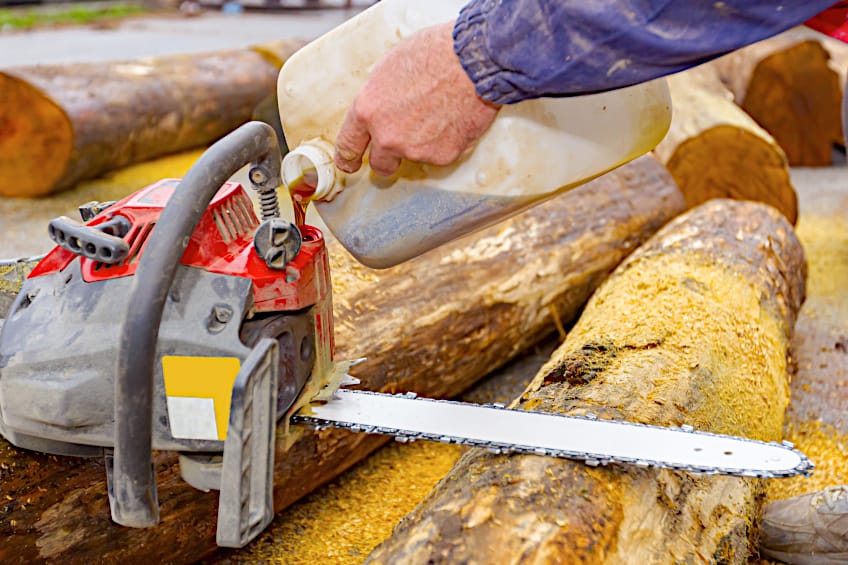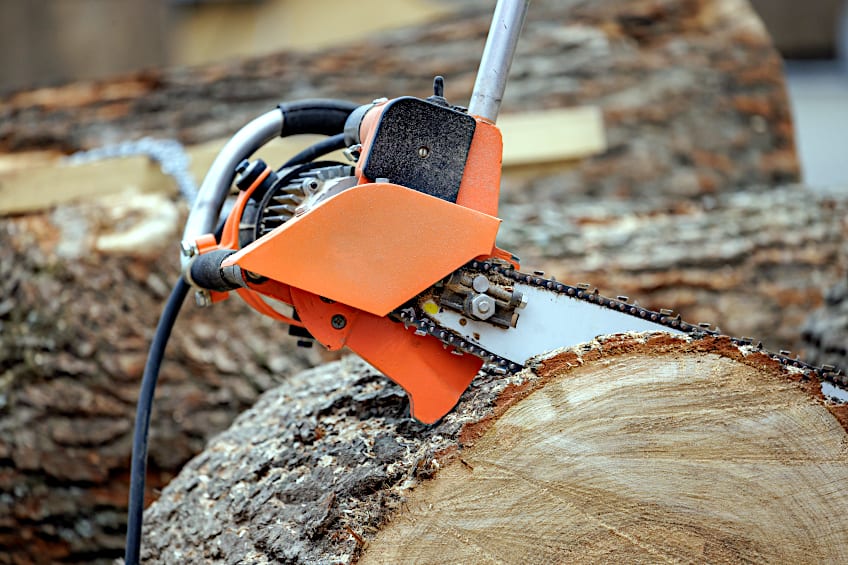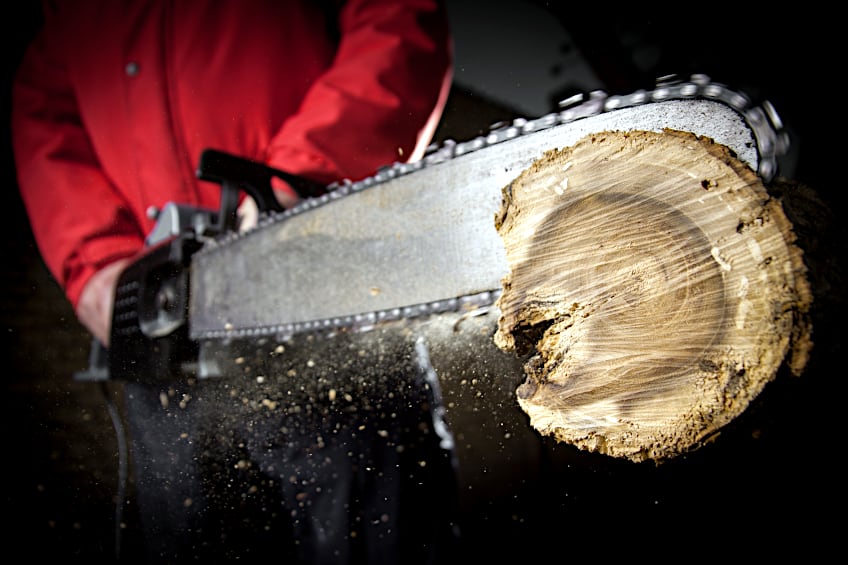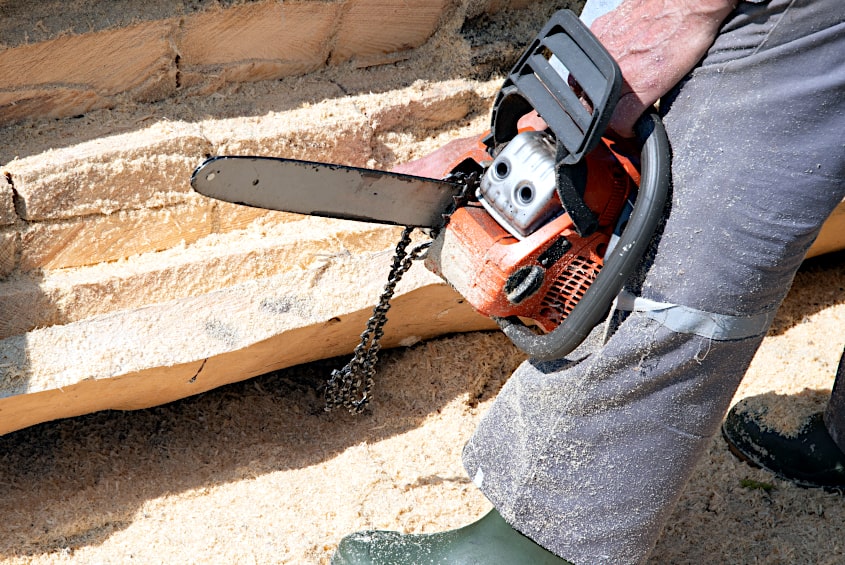Bar and Chain Oil Substitutes – Chainsaw Lubrication Guide
This post may contain affiliate links. We may earn a small commission from purchases made through them, at no additional cost to you. You help to support resin-expert.com
Keeping your chainsaw well lubricated is a crucial part of ensuring that it operates perfectly. However, sometimes you will need to resort to bar and chain oil substitutes in the event that you have run out of the oil recommended by the manufacturer. Not only is this oil important to the functionality of your chainsaw, but it ensures that it lasts long too. So, using alternative oils is a great substitute; however, how do we know what to use? Below, we will discuss everything you would need to know about chainsaw oil substitutes and more!
Table of Contents
What Makes a Good Chainsaw Oil Substitute?
Before we can dive into different oil substitutes for your chainsaw, we need to have a clear understanding of what makes a good substitute. Essentially, there are four factors that you would need to consider, namely the flash point, environmental impact, slipperiness, and stickiness.
Flash Point
The lowest possible temperature at which vapors may ignite is known as the “flash point” of any given fluid.
The greater the flash point, the greater the temperature of the material must be before combustion occurs.
Because chainsaws may reach extraordinary speeds, creating intense heat, selecting a bar and chain oil with an exceptionally high flash point is critical. When diverging from the manufacturer’s suggested bar and chain oil, use high flash point oils to avoid fires and toxic odors.
Environmental Impact
Since chainsaws spray the bar and chain oil you pick all over the place, it is always best to choose non-toxic oil. Non-toxic oil is required for specific operations, such as trimming a tree, sawing wood in your yard, or working close to a body of water.
Keep in mind that the oil you are using to lubricate the chainsaw is dispersed into the air when the blades move.
That means that you and any neighboring plants will be covered in lubricant and anything in it. Your usual bar and chain oil needs to be non-toxic for the sake of safety. Hide any exposed skin before beginning, and only operate chainsaws in well-ventilated places.
Slipperiness
Any bar and chain oil substitutes need to be slippery enough to actually work as an oil. You can easily test the slipperiness of different oils by applying some to your fingertip and thumb. Then try and apply pressure, if it slips, then it is slippery enough to be used on a chainsaw.
Stickiness
The replacement oil needs to be very sticky. This property guarantees that the replacement oil adheres to the chain extremely effectively. During operation, it spins at a rapid pace, preventing the chain from drying out. It also keeps the chain from becoming dry.
A good way to test if an oil substitute is slippery enough is to dip your finger into it. If it sticks to your finger and is difficult to shake off, it would do a good job, as it will adhere to the chainsaw during use.
Why Do Chainsaws Require Chain Oil?
Whether it is an engine or a hydraulic component, oil is a crucial fluid that ensures that metal components operate at their best at all times. Oil provides important lubrication for the bar and chain as it allows the chain to effortlessly glide while simultaneously extending the life of the chain and preventing any friction. When you purchase a new chainsaw, the oil that is applied to the surface does not last very long. Hence, good oil has a variety of benefits such as:
- Reducing the level of dirt that sticks to the chain.
- Preventing the chain from being damaged by glue from tree sap.
- A chain that has been oil-starved runs the risk of slowing down which will lead to a series of issues such as overheating, intense friction, excessive fuel consumption, and ultimately, damage to the chainsaw.
Understanding How the Bar and Chain Work
The chainsaw bar and chain are essential components of your chainsaw, as they represent the cutting mechanism. The chainsaw guide bar and chain collaborate in order to cut through wood or other slightly harder material with ease.
When a power source is connected to your chainsaw, the chain moves in a circular motion with the guide bar to effectively slice through wood.
When you start your chainsaw engine, energy is transferred to the chainsaw chain and the guiding bar, forcing each part to spin in a circular motion. Inside your chainsaw engine, there is a throttle that regulates the amount of energy that flows to the engine as well as the speed of the chain and bar.
Most chainsaws enable you to regulate the chain and bar speed via the throttle according to the job at hand. The circular motion formed guarantees that a suitable amount of friction is created for the effective cutting of the wood or harder material. The chainsaw chain rotates quickly around the guide bar during operation, creating high friction and heat.
To offset this considerable friction, regularly oiling the chainsaw bar and chain would assist in decreasing friction and maintaining good chainsaw bar and chain operation.
What Is a Chainsaw Bar?
Better known as a chainsaw blade or a chainsaw guide, a chainsaw bar is a curved metal bar that is responsible for safeguarding the saw chain while it runs. It sits on the chainsaw’s chains and spins the chainsaw’s chain while enhancing the performance of the saw itself.
For the chainsaw to function correctly, it needs proper lubrication between the chain and the bar while they work.
This would keep it from pressing against the chain and becoming caught, preventing the creation of intense friction, preventing chain burning, avoiding excessive fuel consumption, ensuring the optimum performance of the chainsaw bar, reducing the risk of accidents, and avoiding chainsaw damage.
Oil also prevents sawdust from fouling the chain and blocking the engine. When chainsaw bars are lubricated, they can last as much as 20x longer. Oil is injected into the chainsaw bar via an oil reservoir hole outlet.
Different Types of Chainsaws
For most people, the general goal of utilizing a chainsaw is nearly the same. Yet, some chainsaws are simpler to use than others, while others are less expensive but more difficult to operate. Despite their differences, they are the most effective types of saws ever developed. Below are some of our favorite types of chainsaws.
Mini Chainsaw
A tiny chainsaw is often battery-operated and utilized in circumstances where you would normally use branch pruning shears. But if you either lack the strength or have so much work to do you would be more efficient with a little assistance.
These chainsaws have handles barely larger than a battery-powered power drill and may be used one-handed to down tiny trees, clear up hanging or large fallen branches, or chop small-sized firewood.
Pneumatic Chainsaw
Have you ever questioned what the huge companies use to chop through the heavy trunks of cedar trees? For industrial applications, pneumatic chainsaws are a particularly powerful option. These chainsaws, as the name implies, use compressed air to supply power to the saw blade.
Unlike conventional chainsaws, this one is rather large and has a unique design. The blade is built to be extremely robust and powerful in order to cut through the thickest tree branches and trunks. As a result, this tool is both incredibly heavy and noisy.
Pole Saw
The majority of gardeners choose pole saws over standard saws for pruning and clipping tree branches. Cutting trees along with shaping hedges is a breeze with the extended pole. The tool is made up of three major components: a huge driving rod, a fuel tank or engine, and a tiny standard saw.
Because a pole saw is much longer than a standard chainsaw, it’s cutting occurs at a distance from the user, reducing the danger of an accident.
Different Bar and Chain Oil Substitutes
As per the National Association of Chain Saw Dealers, approximately 60% of chainsaws purchased in the U.S. are suitable for oil substitutes. Yet, bar and chain oil is specifically designed for chainsaws.
However, if you do not have any on hand, there are alternatives that you can use if you run out of bar and chain oil.
The same applies if you are in a remote place and need to get your hands on a substitute. These oil alternatives may be found in any house or any place, and they are inexpensive.
Vegetable Oil
Vegetable oil is one of the most secure options for lubricating your chainsaw. It is biodegradable and non-toxic, and it may even be applied to trim fresh trees without harming you or the plants. One of the biggest advantages is the fact that it is dirt cheap and you may have some in the kitchen at the moment.
Owing to the viscosity of vegetable oil, it may be used without being diluted if necessary. However, this oil is susceptible to clumping and is useless in cold temperatures. When using vegetable oil for the first time on your chainsaw and bar, you may detect leakage. Vegetable oil has a lower viscosity than the oil suggested for the chainsaw bar and chain. This feature causes the oil to flow more quickly. If you discover leaks, simply adjust the oiler flow screw, which may be located beneath the chainsaw.
- Has a high flash point
- Cheap
- Sticky
- Biodegradable
- Completely unusable at low temperatures
Coconut Oil
Coconut oil is an excellent option for chainsaw and bar oil. It is ideal for usage throughout the warmer months. Coconut oil also has an extremely high flash point, which decreases the risk of fire, making it appropriate for your chainsaw chain and bar.
It should be utilized with additives such as vegetable or motor oil to increase viscosity and performance on your chainsaw chain and bar. The oil’s viscosity changes dramatically with temperature. It freezes at 71.6℉, and at that temperature, its viscosity thins. Because of the fluctuating viscosity, the fluid cannot be utilized all year. Coconut oil should only be used if you have no other options.
- Great for warm weather
- High flash point
- Unpredictable consistency
- Needs to be used as an additive for motor or vegetable oil
Engine Oil
Regular motor oil can be used in place of chainsaw guide bar and chain oil. It has an extremely high flash point with an ideal viscosity. Clean automobile engine oil lubricates the bar and chain more quickly than traditional chainsaw chain and bar-specified oil.
Because of the changes in oil viscosity caused by temperature throughout both the summer and the winter months, you can use SAE30 in the summer and SAE10 in the winter. You will also need to verify if the motor oil you want to use on your chainsaw chain and bar is refined.
Keep in mind that engine oil is not environmentally friendly and you will likely end up with oil droplets on anything nearby.
Engine oil is also incredibly flammable and has strong fumes, so it would be best to use a mask while cutting wood.
- Has a high flash point
- Easily accessible
- Has great viscosity
- Harmful to the environment
- Should never be used on living plants
Drained Engine Oil
If you have no supply of clean engine oil, you might use the drain oil from your vehicle to lubricate chainsaws. Drained motor oil is just as effective as new engine oil and would be suitable for your chainsaw bar and guide. However, you will need to filter the oil while it is still warm to ensure that you remove as much of the impurities as possible.
Using old and drained oil as a replacement for your chainsaw carries a risk. A chance that your bar and chain will not be effectively lubricated and that your chainsaw will be harmed as a result of pollutants remaining present in old oil, no matter how carefully filtered it is.
- Cheap
- Just as effective as fresh oil
- Oil impurities can damage the chainsaw
Engine Oil Weights
As an alternative to chainsaw bar oil, regular engine oil can be used. It has enough viscosity to cover the whole blade and will not readily come off when operating at high speeds. Some oils have cold temperature restrictions and will not provide enough lubrication when the air temperature is low.
- SAE30: Excellent cold-weather motor oil. SAE will work well in the cold but will struggle to remain on the blades when the chainsaw warms up. As the temperature rises, SAE10 motor oil may not offer consistent lubrication.
- SAE20: This is a balanced chain lubricant that serves as an alternative to chainsaw bar oil in almost every weather situation. It may deplete quicker than chain bar oil, so check your reserve to prevent causing damage to your blade and wasting gasoline.
- SAE10: This motor oil’s high viscosity keeps it on the chainsaw blade regardless of high temperatures. It has an exceptionally high flashpoint and may be used for an extended period of time. As the temperature decreases, the oil becomes significantly less efficient and should be blended with SAE 10 to ensure an effortless adjustment to cooler climate use.
Canola Oil
Canola oil is an excellent lubricant oil replacement. It is made from rapeseed oil and has qualities comparable to vegetable oil, although it is more flexible. Canola oil is thinner compared to vegetable oil. This would be an issue since it would not adhere properly to the chain and would simply fly off during use. Canola oil’s viscosity does not make it a long-lasting option, but it is useful and an excellent supplement to other oil replacements.
Because of the sensitive nature of canola oil along with its viscosity, it is best utilized in the winter or at low temperatures, since it adheres extremely strongly to the chain when used in chilly conditions. As a result, it is a fantastic choice when the temperature is simply too low to utilize vegetable oil.
- Cheap
- Environmentally friendly
- No risk of skin irritation
- Does not adhere to the chain very well
Diesel
Diesel is an excellent mineral oil for the chainsaw bar and guide. When operating in sub-zero temperatures, diesel is quite useful since it can tolerate freezing and severe temperatures.
However, since diesel is a fuel, we would suggest that you only use it as a last resort since the possibility of things going wrong is quite high due to the relatively low flash point, but it is not as volatile as regular gasoline.
- Easily obtainable
- Works well in freezing temperatures
- Emits harmful fumes
- Not environmentally friendly
Hydraulic Fluid
Hydraulic oils for fluid machinery, such as hydraulic pumps and excavators, are accessible if you are fortunate enough to have access to them. Another type of hydraulic fluid is the oil used in automotive braking systems. Since it has an extremely high flash point, strong lubricating qualities, inhibits rust and corrosion, and performs well in low-temperature settings, hydraulic oil might be an ideal chain and bar lubricant.
Use suitable safety equipment while working with hydraulic fluid as it can be dangerous at high pressure. While utilizing hydraulic fluid, keep your skin along with your nose safe by wearing personal protective equipment. When selecting a hydraulic oil for the chainsaw, make sure it is environmentally safe, has good lubricating capabilities, and uses a refined hydraulic oil for the chainsaw bar and guide.
- Prevents rust and corrosion
- Works well in low temperatures
- High flash point
- Excellent lubricant
- Emits strong fumes
- Can be dangerous under pressure
Drained Hydraulic Fluid
When you need to operate your chainsaw but are out of the suggested oil, you may rely on properly drained hydraulic oils from the power machinery. Your chainsaw and bar will be lubricated with drained hydraulic oil. It has a very high flash point and is appropriate for use in cold weather.
You will need to drain the fluid with a clean cheesecloth over a funnel a few times before it is safe to use.
However, make sure you avoid using drained hydraulic oil for an extended period of time since pollutants, waste, and impurities will still be there, potentially damaging your chainsaw.
- Works well in low temperatures
- High flash point
- Emits strong fumes
- Can damage the chainsaw
Olive Oil
You might also use olive oil for your chainsaw. If you have a bottle of olive oil on hand, it will be enough to properly lubricate your chainsaw bar and chain. It is biodegradable and has strong lubricating characteristics.
The only negative is that it may be a little pricey, but not as pricey as the suggested chainsaw oil.
- Biodegradable
- Excellent as a lubricant
- Easily obtainable
- Expensive
Power Steering Fluid
Your vehicle’s power steering and gear fluid are ideal for your chainsaw’s lubrication. Power steering fluid and gear oil, for example, are excellent chain lubricants.
These are mild oils that help keep your chain brake and bar from jamming. They would sufficiently lubricate your saw bar and chain, lowering or eliminating extreme friction.
- Lightweight
- Excellent viscosity
- Easily stains clothing
- Bad odor
Increasing Oil Efficiency
The majority of these alternative oils will act as lubricants for your chainsaw blade. Using the proper oils is critical for your machine’s long-term health, but the impact that alternative oils may have on chainsaw performance and the environment must be addressed. Follow these guidelines to maintain your chainsaw running safely.
Crank up the chainsaw prior to changing or draining the oil.
Allow the oil that has previously been placed on the blade to heat up and form a liquid before operating the blade. Allow the blade to spin slowly to thoroughly cover the chain without splattering oil all over. You may start cutting branches after the oil is hot and your blade is fully greased.
Unless you use the manufacturer’s oil, you will usually run out of oil sooner than your gasoline runs out. Should you run out of chainsaw oil yet continue to work with the remaining fuel, you risk damaging your blade and making your cuts much more difficult. Check the oil bar reservoir on a regular basis and replenish it promptly if it is empty.
You may also pay attention to noises that suggest your chainsaw is straining, indicating that extra lubrication is required.
The key strategy to keep your chainsaw in good working order is to use non-toxic alternatives. Plant-based oils are less corrosive to interior parts and may be blended to provide the right viscosity for your environment. These alternatives should be extensively researched because they emit no toxic odors, leave fewer stains on clothing and wood, and cause less environmental damage to your immediate environment.
Most major chainsaw manufacturers now also provide non-toxic petroleum-free supplies in addition to regular bar oil.
The Impact of Using Substitute Oils
Nothing is more dangerous than operating a chainsaw without sufficient lubrication. Cutting wood may easily cause blade breakage and other preventable calamities due to the friction and tremendous heat created. Using a replacement oil is always preferable to running your machine dry.
Choosing a replacement oil that is suitable for your chainsaw as well as your environment might be difficult, but there are many possibilities. Mixing various vegetable-based oils or oils of varying weights that are suitable with bar oils might assist in enhancing the lubricant’s life and preserve your equipment.
These formulae can also improve the performance of your chainsaws, conserving fuel and generating better cutting outcomes in a shorter period.
The most crucial reason to think about chainsaw bar options is to safeguard both the natural environment and the things being cut. When operating at high speeds and temperatures, motor oil and regular chainsaw oil can create black streaks and splatter all over the land. Wood artisans and ecologically conscientious loggers choose non-toxic and non-staining options.
Voiding the Warranty
It is critical to note that using any other lubricant than the prescribed bar and chain oil by the manufacturer may void any warranties or maintenance claims. Most manufacturer policies do not cover the following:
- Repairs that are necessitated by incorrect oil mix ratios or the use of oils along with additional lubricants that are not stated in the product’s instruction manual.
- Failure was caused by oils not recommended or supplied by the chainsaw manufacturer.
- Repairs that need to be done due to poor maintenance, oil deposits, or lubrication.
Other chainsaw brands are likely to have identical warranty limitations. While no one will notice if you use a different oil every now and then when you run out, frequent use will be clear to those who understand what they are looking for.
Basic Chainsaw Tips
Chainsaw chains are constructed of metal and must be lubricated on a regular basis. Oil is required for the bar and chain to glide freely, extending the life of chainsaws. This lubricant reduces friction, which can harm your chains. Here are some tips to ensure that you conduct proper maintenance.
- Do not use your chainsaw when it has run dry.
- Use oil substitutes with other oils to get the proper viscosity.
- Always filter used oil to avoid getting dirt from clogging the oil pump.
- Do not use an oil alternative that is completely different from the manufacturer’s product.
Chainsaws are incredibly useful tools, but like any power tool, it does require maintenance to ensure that they operate at their best. Using oil substitutes can save you some money and they are less harmful to the environment if you are usually working in an outdoor area populated by many trees and plants. Nevertheless, we hope that you have learned enough to ensure that your chainsaw is always in the best condition!
Frequently Asked Questions
What Is Considered to Be the Best Bar and Chain Oil Substitute?
When considering all factors such as the flash point, viscosity, and environmental impact, the best alternative to chainsaw oil is vegetable oil. While it can get a bit clumpy once the colder weather sets in, it will continue to work well and naturally breaks down over time, which is great for the environment.
Why Should We Consider the Flash Point of the Chainsaw Oil Substitute?
The flash point is the lowest temperature that will cause an oil or other liquid to quickly form a vapor near the surface that will result in a brief ignition when exposed to an open flame. Therefore, the higher the flash point, the better it would perform as a chainsaw oil substitute, as it will take much longer to combust when exposed to high temperatures.
How Is a Bar and Chain Oil Substitute Different from Chainsaw Oil?
Chainsaw oil is designed to be used on chainsaws, meaning that it has the perfect viscosity and flash point to ensure that the chainsaw can be used in any weather conditions. Using an alternative to chainsaw oil means that you sacrifice certain qualities of the oil itself, so the chainsaw will not operate at its best. Chainsaw oil alternatives are usually natural or synthetic oils, but their uses will range from cooking to lubricating engines and their components.

















